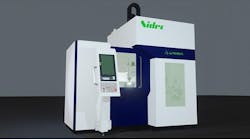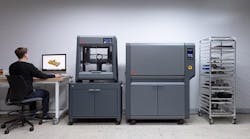Metal X is the first 3D printer to harness the company's breakthrough additive technology in metal manufacturing—Atomic Diffusion Additive Manufacturing (ADAM). The system allows users to create shapes and geometries that cannot be machined or produced with today's metal printers, opening up new possibilities for lighter parts with advanced built-in functionality.
The ADAM technique produces robust, accurate parts across a wide range of engineering metals. Parts are printed, layer-by-layer, using a metal powder contained in a plastic binder. After printing, plastic binders are removed and the part is sintered into customary engineering metals. By sintering the entire part at once, ADAM technology allows metal crystals to grow through the bonded layers, effectively erasing the layer-to-layer strength reduction of many other 3D printing processes.
Metal X prints high-end stainless steels such as 17-4 PH stainless steel, Copper, H13 Tool Steel, Inconel 625, and A2 & D2 Tool Steel.
Built on innovations pioneered in the Mark X carbon fiber printer, the Metal X features an industrial-grade print platform, enabling the accurate creation of metal parts in an amazingly compact enclosure. The first printer to feature ADAM technology, the hardware, software, and materials work together to ensure a seamless printing experience that any engineer or manufacturer can learn quickly.
Build Volume: 9.8 x 8.6 x 7.8 in. (250 x 220 x 200 mm)
Footprint: 22.6 x 18.3 x 56 in. (575 x 467 x 1432 mm)
Materials:
- 17-4 Stainless Steel
- 303 Stainless Steel
- 6061 Aluminum (Beta)
- 7075 Aluminum (Beta)
- A-2 Tool Steel (Beta)
- D-2 Tool Steel (Beta)
- IN Alloy (Inconel) 625 (Beta)
- Titanium Ti-6Al-4V (Beta)
Inspection Parameters:
- 50-micron beam diameter
- 1 micron Z resolution
- z layer resolution
- 50 micron
Software Features:
- Single Sign-On
- Two-Factor Authentication
- Organization Admin Portal
- Early Access to New Features
- Software delivery
- Cloud-based
- Local Storage






